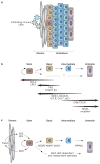Normal and neoplastic urothelial stem cells: getting to the root of the problem
- PMID: 22890301
- PMCID: PMC3468664
- DOI: 10.1038/nrurol.2012.142
Normal and neoplastic urothelial stem cells: getting to the root of the problem
Abstract
Most epithelial tissues contain self-renewing stem cells that mature into downstream progenies with increasingly limited differentiation potential. It is not surprising that cancers arising from such hierarchically organized epithelial tissues retain features of cellular differentiation. Accumulating evidence suggests that the urothelium of the urinary bladder is a hierarchically organized tissue, containing tissue-specific stem cells that are important for both normal homeostasis and injury response. The phenotypic and functional properties of cancer stem cells (CSCs; also known as tumour-initiating cells) from bladder cancer tissue have been studied in detail. Urothelial CSCs are not isolated by a 'one-marker-fits-all' approach; instead, various cell surface marker combinations (possibly reflecting the cell-of-origin) are used to isolate CSCs from distinct differentiation subtypes of urothelial carcinomas. Additional CSC markers, including cytokeratin 14 (CK14), aldehyde dehydrogenase 1 family, member A1 (ALDH1A1), and tumour protein 63 (p63), have revealed prognostic value for urothelial carcinomas. Signalling pathways involved in normal stem cell self-renewal and differentiation are implicated in the malignant transformation of different subsets of urothelial carcinomas. Early expansion of primitive CK14+ cells--driven by genetic pathways such as STAT3--can lead to the development of carcinoma in situ, and CSC-enriched urothelial carcinomas are associated with poor clinical outcomes. Given that bladder CSCs are the proposed root of malignancy and drivers of cancer initiation and progression for urothelial carcinomas, these cells are ideal targets for anticancer therapies.
Conflict of interest statement
The authors declare no competing interests.
Figures


References
-
- Wagers AJ, Weissman IL. Plasticity of adult stem cells. Cell. 2004;116:639–648. - PubMed
-
- Takahashi K, Yamanaka S. Induction of pluripotent stem cells from mouse embryonic and adult fibroblast cultures by defined factors. Cell. 2006;126:663–676. - PubMed
-
- Weissman IL. Stem cells: units of development, units of regeneration, and units in evolution. Cell. 2000;100:157–168. - PubMed
-
- Watt FM, Lo Celso C, Silva-Vargas V. Epidermal stem cells: an update. Curr Opin Genet Dev. 2006;16:518–524. - PubMed
Publication types
MeSH terms
Grants and funding
LinkOut - more resources
Full Text Sources
Other Literature Sources
Medical
Miscellaneous

